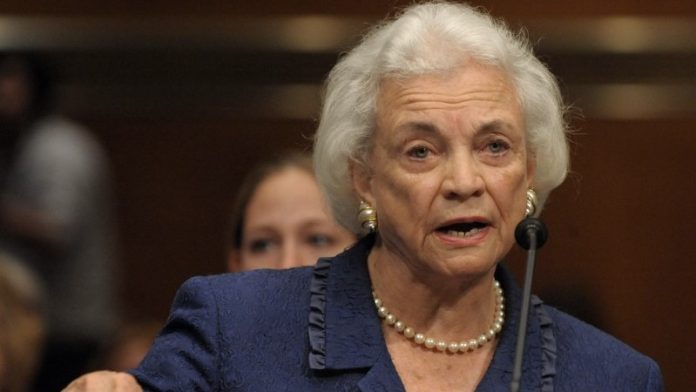Dec. 1 (UPI) — Sandra Day O’Connor, the first woman to serve as a U.S. Supreme Court justice, died Friday in Phoenix, the court announced. She was 93.
The New York Times reported the cause of death was complications of dementia.
O’Connor was appointed to the court in July 1981 by President Ronald Reagan after working as a public attorney and serving in all three branches of government in Arizona.
Born in El Paso, Texas, and raised in Arizona, Sandra Day grew up on a cattle ranch with no running water or electricity. She enrolled at Stanford University at age 16 and graduated magna cum laude with a degree in economics. In 1952, she earned a law degree from Stanford Law School, where she met and eventually married John Jay O’Connor III.
Together, they had three sons.
Sandra Day O’Connor was appointed to the Arizona State Senate in 1969, and became the first woman to serve as majority leader in any state in 1973. A year later, she was appointed to the Maricopa County Superior Court and five years later rose to the Arizona Court of Appeals, where her colleagues showered her with praise upon her 1981 U.S. Supreme Court nomination.
“She has a razor-sharp mind which, combined with a steady temperament, makes her well-suited for the tough questions that would be presented to a U.S. Supreme Court justice,” appeals Judge Donald Froeb said at the time.
O’Connor was confirmed unanimously by the U.S. Senate in the first televised confirmation hearing for a Supreme Court justice. The three-day Senate Judiciary Committee hearing drew praise for O’Connor, who testified, “The proper role of the judiciary is one of interpreting and applying the law, not making it.”
She was also asked about her legacy as the first woman justice, to which she replied she would like to be remembered as a fair-minded jurist. “I would settle for an epitaph saying I decided the issues raised before the court on a reasoned basis.”
She was sworn in to the U.S. Supreme Court on Sept. 25, 1981, pledging in part, “I will administer justice without respect to persons, and do equal right to the poor and to the rich.”
She wore the same black robe from her days on the Arizona Court of Appeals and quipped, “I’ll buy a new one eventually, when this one gets frayed.”
During her next 25 years on the high court, O’Connor was influential in decisions on abortion rights, criminal procedures and racial affirmative action.
Initially, her voting record aligned closely with conservative Justice William Rehnquist, but later she became the swing vote on the court, where she joined the controlling opinion in Planned Parenthood vs. Casey. The 1992 decision reaffirmed the constitutional right to abortion established in Roe vs. Wade.
O’Connor was also instrumental in the Bush vs. Gore case that ended challenges to the results of the 2000 presidential election. O’Connor joined with four other justices, a decision she regretted years later. In an interview with the Chicago Tribune Editorial Board, O’Connor said the Supreme Court “took the case and decided it at a time when it was still a big election issue. Maybe the court should have said, ‘We’re not going to take it, goodbye.'”
She underwent successful breast cancer surgery in 1988 and did not miss any oral arguments while she was recovering. She announced her decision to retire from the court in 2006 to take care of her husband, who was suffering from Alzheimer’s and later died.






